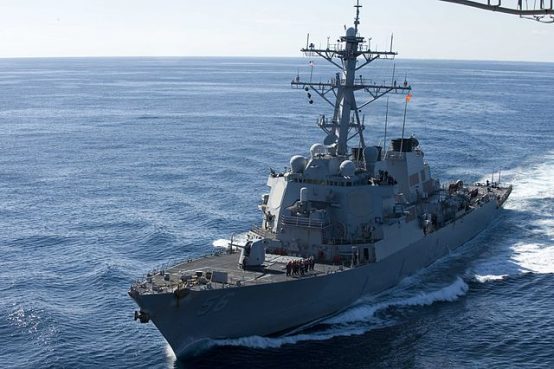Lack of Money is Not What Caused Fatal Ship Collisions

As someone who spent 24 years in the U.S. Navy, qualifying as a naval flight officer navigator and tactical coordinator, and as officer of the deck, I am heartbroken and concerned about what may have caused the recent crashes of naval ships in the Pacific.
I am heartbroken because a total of 17 enlisted sailors who had volunteered to defend the nation were were killed, and for no good reason, the result of a June crash involving the USS Fitzgerald destroyer and a Philippine flagged container ship in the busy approaches to Tokyo Bay, and an August collision of the USS John McCain destroyer and a Liberian flagged tanker near the heavily traveled Strait of Malacca.
 I am concerned that the leadership of these two modern U.S. Navy ships—each equipped with radars that can track objects smaller than a meter in size, satellite navigation aids, collision warning systems, and an array of other sensors to provide situational awareness—allowed this to happen and that some are using these tragic incidents to push another agenda.
I am concerned that the leadership of these two modern U.S. Navy ships—each equipped with radars that can track objects smaller than a meter in size, satellite navigation aids, collision warning systems, and an array of other sensors to provide situational awareness—allowed this to happen and that some are using these tragic incidents to push another agenda.
The first crash that resulted in casualties occurred at night on June 17 as the USS Fitzgerald approached Tokyo Bay. The captain and his deputy, the executive officer (XO), were both sleeping upon impact, leaving the ship in the hands of younger, less experienced officers and sailors. Seven sailors died. This is a dereliction of duty which, after an investigation, has appropriately resulted in the captain and his XO being relieved of duty, effectively ending their careers.
We still do not know who was in charge of the USS John McCain as it approached Singapore on August 21. We do, however, know that a crowded waterway requires the utmost vigilance from the captain and the crew, and that an investigation is currently underway. A total of 10 sailors’ bodies were recovered after that tragedy.
But even if the captains were sleeping, the people on duty, with the help of the available technology, should have been more than capable of preventing these highly maneuverable ships from running into lumbering cargo ships and tankers. Were the sailors not adequately trained or was the technology not working properly? If so, why not?
It is troubling that proponents of an even larger defense budget, and the Navy in particular, are using these tragic events to push an agenda instead of dealing with the actual problems at hand. With a current budget of $700 billion, proponents of increasing the defense budget ignore the fact that, as General David Petraeus and Michael O’Hanlon recently pointed out, the U.S. already accounts for more than one-third of the world’s military expenditures and spends more than three times as much as China and 10 times more than Russia. Moreover, they note that the state of our military is more than adequate, and that large increases in the defense budget are unnecessary.
Proponents of increasing our military expenditures also claim that, as a result of the Budget Control Act (BCA), the defense budget has been cut by $200 billion since 2013. However, this argument ignores the fact that $180 billion in the Overseas Contingency Operations (critics call it the “Pentagon Slush Fund”)—which is not impacted by sequester—has been spent on items having nothing to do with the wars. Congress has also granted the Pentagon another $50 billion in relief from the caps.
Additionally, several defense hawks have used the tired talking point that the Navy is smaller than at any time since before World War I, while blaming President Barack Obama for the “insufficient” size. Yes, it is true that today’s naval fleet of 272 ships is smaller than the fleet in 1916. But would you rather have today’s fleet consisting of 11 aircraft carriers and 84 cruisers and destroyers, or the 36 battleships and 28 gunboats from 1916?
Moreover, since it takes dozens of years between the time a ship is funded until it becomes operational, the size of today’s Navy is primarily the result of decisions made by the George W. Bush administration. In fact, 80 ships that received funding from the Obama administration are currently under construction as the size of the Navy will expand to more than 300 ships by the end of the decade, all without a dramatic increase in the Navy budget.
Finally, the reason that the Navy does not have more ships is not because of insufficient funding, but rather a result of how poorly the Navy manages the funds that it is allocated. For example, the USS Gerald Ford, the aircraft carrier that President Donald Trump used as a platform to call for a larger Navy, was two years behind schedule and 30 percent over budget (currently at $13 billion). Those several billion dollars of cost overruns would have permitted the Navy to build several more cruisers and destroyers or increase its manpower.
And then there is the Littoral Combat Ship (LCS). The Navy planned to build 55 of these vessels for $40 billion, or about $725 million each. Instead, the Navy will spend the same amount of money while building no more than 20 vessels. Additionally, if the Navy wanted to put more money into its shipbuilding account, it could buy the FA-18-E/F for half the price of the F-35’s that they are currently purchasing.
Just as there has been a failure of leadership among the Navy’s top officials in the Pentagon, other officials in the operational chain of command are responsible for the increased likelihood of these accidents.
First, in 2003, the Navy cancelled the intensive six-month course at the Surface Warfare Officers School (SWOS). During these six months, young officers studied navigation, basic seamanship, engineering, and maintenance before being assigned to their first ship. This was the equivalent of what navigators, like myself, did before going to our first aircraft squadron. Although the Navy instituted a 14-week course last year, the damage was done.
Second, the Navy’s senior leadership in the Pacific leaves much to be desired. While the deaths on the Fitzgerald and the McCain garnered the attention of the hierarchy, two serious incidents earlier this year, though they did result in casualties, should have gotten their attention as well. On January 31, the guided missile cruiser, Antietam, ran aground in Tokyo Bay, and on July 9, the guided missile cruiser, Lake Champlain, collided with a South Korean vessel east of the Korean Peninsula. Had the Navy ordered a stand-down as it did after the Fitzgerald and McCain tragedies, these two tragedies might have been avoided.
Third, in addition to the accidents, there was the missing carrier situation. On April 8, the Navy’s Pacific command leaked to the press that the USS Carl Vinson and its four escort ships would arrive off the coast of North Korea by April 16, the same day that Kim Jong-Un would celebrate his grandfather’s birthday with a parade and ballistic missile test. On April 11, Secretary of Defense James Mattis, after meeting with Admiral Harry Harris, the head of the Pacific Command, said that the Vinson was on its way.
Unfortunately, not only did the Vinson not arrive off the coast of the Korean Peninsula in time to send a powerful message during North Korea’s parade and missile test, it was actually sailing in the opposite direction in order to take part in joint exercises with the Australian Navy in the Indian Ocean, about 3,500 miles southwest of the Korean Peninsula.
Fourth, in addition to losing an aircraft carrier, the Navy’s Pacific Command has also seen several of its people taking prostitutes, cash gifts, and other favors from a Malaysian defense contractor, Leonard Francis, known as Fat Leonard, in exchange for inside information that he used to make millions of dollars.
It is clear that the problem is not money. The real problem, especially in the Pacific, is leadership. After these two tragic incidents, the Navy ordered an operational pause. Why did they do nothing after the two incidents earlier this year? Similarly, why did the Pacific Command not know that an aircraft carrier was not going toward North Korea, but going the opposite way? And why did the Bush administration allow the Navy to cancel the Surface Warfare Officer Course?
The good thing about the Navy is that while they give commanding officers and fleet commanders a great deal of authority, they also hold her or him responsible for whatever happens in their command and make them pay a price for whatever goes wrong. As a result, the captain of the Fitzgerald and the Commander of the Seventh Fleet have already been removed. But it should not stop there.
Lawrence Korb is a senior fellow at the Center for American Progress and a senior adviser to the Center for Defense Information. He was formerly director of national security studies at the Council on Foreign Relations, and served as President Reagan’s Assistant Secretary of Defense (Manpower, Reserve Affairs, Installations and Logistics) from 1981 to 1985.
Comments